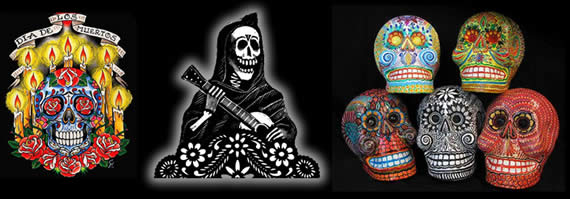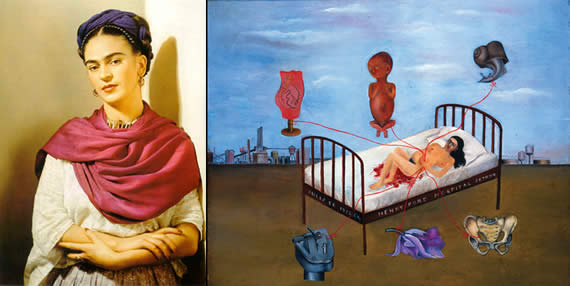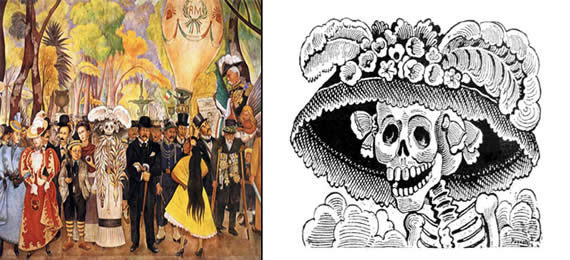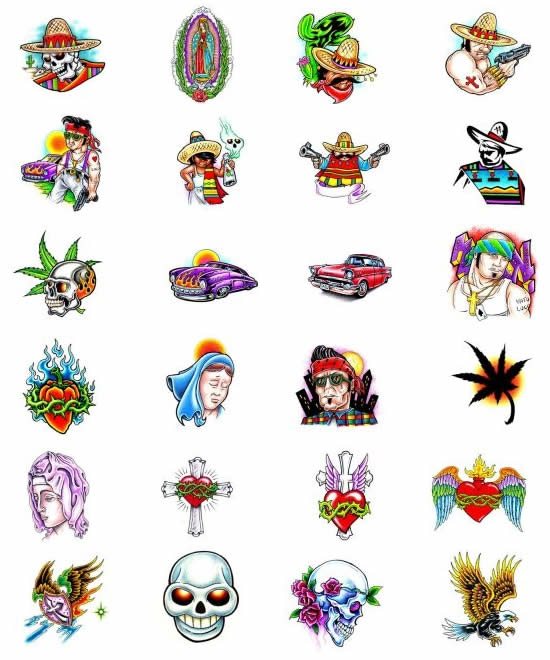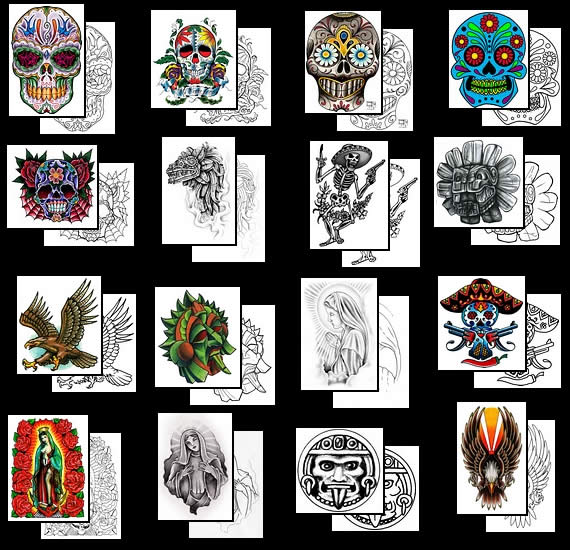|
|
|||
 |
|||
|
TATTOO DESIGNS & SYMBOLS - LATINO TATTOO MEANINGS
Tattoo Symbol Index - A B C D E F G H I J K L M N O P Q R S T U V W X Y Z Tattoo designs - L >> Latino
One of the biggest fiestas - and a reason to celebrate and party - is known as Cinco de Mayo (May the 5th 1862) , a celebration of freedom and liberty. It's the Mexican version of the Fourth of July-not their independence day, but a party to celebrate the vanquishing of foreign invaders. Little wonder that Americans from all over the union are starting to embrace the Cinco de Mayo celebration, and to acknowledge the Mexican pride that comes with it. Mexican pride is here to stay, and the tattoos that announce it are worn mainly by Latinos who've ventured north of the border for work. Pride of heritage has given birth to a genre of tattoo that includes the geographic shape of their home state-Oaxaca, Michoacan, Sonora, for instance-combined with a family name or crest. For some immigrants, the ever-popular flag motif appears as a pair of flags, the Star Spangled Banner and the Mexican eagle. Perhaps this tattoo is an attempt to cool frictions that often flare up while living amongst those few Americans who resent the Chicano presence in the U.S. That antagonism has caused some Mexican-Americans to fight back with Latino tattoos that are defiantly pro-Mexican-or defiantly anti-American. Like an 'anti-INS' tattoo.
La Migra, the Immigration and Naturalization Service, is a favourite tattoo-target for immigrants who've found the border to be hostile territory. Once the migrant has legally established an American base, however, he or she may commission a more benign tattoo, like a portrait, the likeness of a wife or child, as a reminder of loved ones left behind. More radical immigrants may take up the cause of 'worker rights', and take on a tattoo celebrating historic labor heroes like Cesar Chavez, a Mexican-American who fought for the rights of migrant farm workers in America. But political tattoos can't compete with religious tattoos among Mexicans on the both sides of the border in terms of outright popularity. Most Latinos are Roman Catholics, whose homes are decorated with a host of religious imagery that includes the sacred heart, crosses, crucifixes, saints, and Jesus, either in the classic sacred heart, or depicted on a cross. Many Latinos feel further compelled to imprint themselves with these icons of faith, as tattoos.
The All-Star in the pantheon of Roman Catholic figures, however, is the Blessed Virgin Mary, and there are few tattoos so instantly recognizable. She's known in Mexico as La Virgen de Guadalupe, or the Virgin of Guadalupe, and she holds a special place in the hearts of most Mexicans. The well-known icon shows a brown-skinned Mary, her hands clasped in prayer, casting a sombre downward look. She stands on a crescent moon, which is held up by an angel. Light emanates from her entire body. Because the history of the image is so 'Mexican', it has cultural as well as religious associations. The story goes like this: Once upon a time-centuries ago-the Virgin revealed herself to a man for the purposes of having him build a church. Her instructions included the cryptic request to pick some roses, which, being winter, seemed absurd, yet there they were on a frozen hillside. The man gathered the roses in his poncho and presented them to the local priest, proclaiming a botanical miracle, but the greater miracle lay in the imprint left behind by the roses on the poncho-the likeness of the Virgin. That image-still in existence-has become the arch Latino religious tattoo design. And because of the symbolism of the roses, rose tattoo designs are among the most popular, and a potent symbol of faith among Latinos.
Note-the brown-skinned Virgin is said to be a unifying symbol for Mexico. In 1810, it became the symbol for Mexican independence, when a priest-activist applied it to a banner. It has also appeared more recently in demonstrations calling for immigration rights. Among male Latinos, cross tattoos are incredibly popular and are often done on a epic scale - sometimes inked so large that they cover the breadth of the chest or take up the entire back. Women tend more to the sacred heart on the chest. All these religious tattoos are no less popular among Latinos and Chicanos in prison. Many more Latino tattoo motifs hearken to the immigrant's homeland. From the already mentioned Mexican flag, to symbols of the ancient Aztec and Mayan cultures upon which Mexico is built. Skulls are another major Mexican theme, symbolic of the Day of the Dead, and by extension, a popular motif in Latino tattoo art. The eagle emblem is everywhere in Mexico, on every flag, government office, and on a lot of bodies decorated with body art. The Mexican eagle holds a snake in its mouth, and presents a dramatic sight. The tattooed image speaks of Aztec ancestors, as well as national pride. Where the tattoos are expressly Aztec or Mayan, they are instantly recognizable as such, and are quite frankly some of the most bold and graphically exciting motifs to be seen anywhere. The sun figures frequently in these Aztec tattoos, as do snakes, jaguars and an astonishingly varied and rich collection of underworld figures and spirits. This is a rich cultural tradition to mine for original tattoo ideas and imaginative designs.
In the daily life of an Aztec-around 600 years ago-pleasing the gods was a priority. No god was more important than Huitzilopochtili, the sun god, the giver of life and guardian of the heavens. He is depicted as a blue character with a headdress of hummingbird feathers. And fully armed. Today, that Aztec sun tattoo might very well symbolize a belief in the afterlife, which may explain why this celestial character was often depicted in a serious mood. No inane 'happy face' for Huitzilopochtili.
Americans of all stripes have taken to the skull and crossbones motif in a tattoo, but nobody celebrates the skeleton like Latinos. Their excuse to 'raise the dead' is of course their 'Day of the Dead' celebration on November 1st . But it's anything but macabre. In Central and South America, the human skeleton is suggestive of our amorphous essence, or 'soul'. Families gather to remember friends and relatives who have broken through the material plane of reality to enter a place of less suffering. And what's more, they're anxiously awaiting the day we join them there. What could make a better tattoo than a symbol of transcendence?
For the Dia de los Muertos celebration, many people will get tattooed with name of a loved one no longer present. The memorial tattoo might go so far as a portrait of the deceased-but likely in the form of a skeleton. Sounds spooky to a non-believer, but it helps to accept that they're no longer in the flesh. The skeletons are brightly dressed and are usually depicted dancing or playing a guitar. Their spirit lives on! And as more people 'get it', these Day of the Dead symbols find their way onto more living bodies as tattoos. Day of the Dead motifs have their own color code-pink for joy-red for blood, life, and sacrifice-purple/indigo for grief and mourning-white for home and purity of spirit-and orange for the dawn of a new day. Latinos would probably stick to the folk art style, but the dead aren't going to object to a cartoon-style skeleton, or the Sailor Jerry look. And when thinking of an appropriate 'Latino' or Mexican folk art style, there is an extraordinary body of work by internationally acclaimed artists like Frida Kahlo and Diego Rivera (the history and relationship between Frida and Diego is worth all the research on its own!) and many others such as Rufino Tomayo and David Alfaro Siqueiros and Rivera Orozco. Some of their finest work was political in nature, and their images were rendered in giant murals where the images served to inspire the viewer.
Fiestas in general are a popular time for Latinos to take on a tattoo, whether it's the Dia de los Muertos, or Cinco de Mayo, or any of the many Mexican celebrations that have evolved out of 'folk Catholicism'. There's always plenty of danzas and balet folklorico and pageants and costumes and fireworks, but at the heart of most fiestas you find 'faith'. That's what you find in the hearts of most visitors to the tattoo studio at fiesta time. The belief in something so strong that people are proud to wear it on their sleeve-or shoulder or chest or back or wherever they are so inspired. And once again, it's the Virgin of Guadalupe who appears most often, a vision all over again, emerging on the bodily canvases of Latinos young and old. The popularity of Latino traditions in the U.S. has helped to transform the Cinco de Mayo festivities into a celebration of all things Mexican. In fact, it's becoming a bigger occasion in the U.S. than in Mexico. Why? Because Americans love the triumph of the underdog. It's the perfect excuse to party till dawn, and if a tattoo has found its way into the fiesta agenda, well, that's part of the Latino tattoo tradition.
The darker side of Latino tattoos concerns the 'cholo', or Chicano gangster. From the barrios of East L.A. comes this carefully tended apparition dressed in chinos (baggy khaki pants), a sleeveless T or flannel shirt buttoned only at the top, with either a shaved head, or else a hairnet or bandana around the forehead. He typically drives a low-rider, and is associated with a type of 'Old English style' graffiti called 'placa' or 'hit-up', which marks gang turf. Cholo tattoos follow the same convention, often messages or family names in the same calligraphy, placed on the neck or face. The markings are often crude, intended as badges of identity, like the 5-pointed crown, or 5-pointed star, denoting membership in the gang. Other hand tattoos might signify specific criminal activities or affiliations, like the number '13' (for the 13th letter of the alphabet, 'M', for Mexican Mafia). Many of these gang tattoos have become trendy, making insidious inroads to mainstream culture. Celebrities like Justin Timberlake, Eminem, and Beyonce have followed the cholo scene right into the East L.A. tattoo studio of Mr. Cartoon, whose fine-line work is second to none. What's a legitimate gangbanger supposed to do when every sexy little chica and wannabe homeboy is sporting the marks of the brotherhood? Of course, Catholic imagery is also a big part of cholo tattoo culture. The 'praying hands' tattoo implies that the wearer is 'praying to God for forgiveness' for his sins. The previously mentioned 'Lady of Guadalupe' is popular for much the same reason-for the 'chola' no less than the 'cholo'. She might have a teardrop tattooed under one eye, a striking compliment to her dark lipstick and teased black hair. But all this might be out of date by this time next week. Cholo culture, like everything else, is evolving. Don't look to Cheech and Chong for your present day cholo cultural cues.
(By the way-'cholo' in South America means indigenous peasant. If
anyone out there knows or has information about their tattoo
culture, please let us know.) "In my tattoo, the Virgin is holding a Black baby and a Latino baby. Minorities are so quick to attack one another when we should all be working together to heal this country and the world. That is what my tattoo is about-using our collective history as a strength but not letting lies and propaganda shape the way we see each other. It is also about not letting icons, symbols and rituals from our own culture oppress us by limiting the ways we can express ourselves." See also: Religious Tattoo Index, Latino Tattoo Index
Choose your own Latino tattoo design from Tattoo-Art.com.
Pick out some great Latino / Mexican Tattoo Ideas HERE at TattooJohnny.com! Tattoo designs - L >> Latino Tattoo Symbol Index - A B C D E F G H I J K L M N O P Q R S T U V W X Y Z |
||
| Celeb Tattoos | Facts & Stats | Designs & Symbols | History | Culture | Links | Tattoo Galleries | Contact | |||
|
|
|||




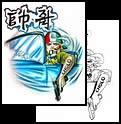

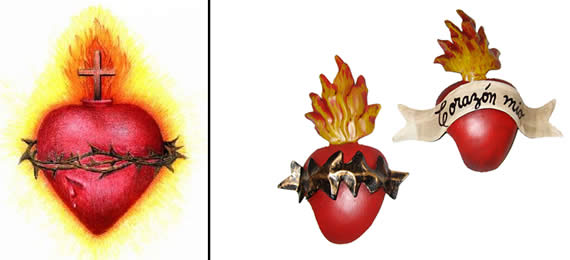
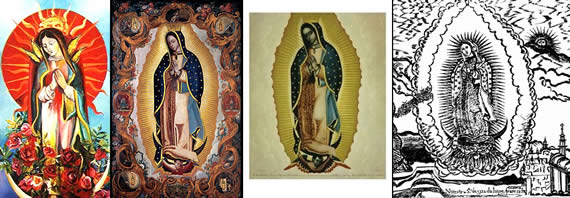
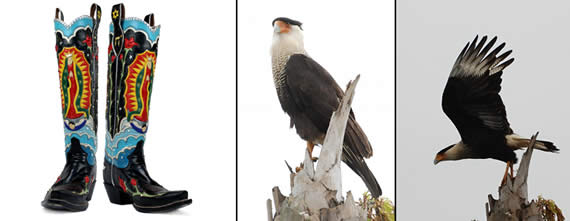
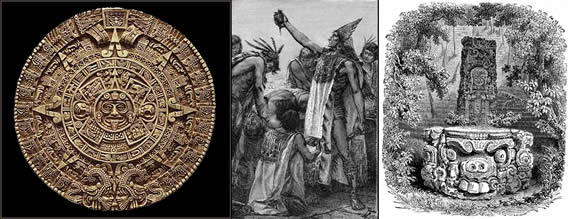
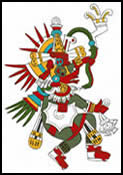 The Aztec dagger-once used to tear out the still-beating heart of
human sacrifices as an offering to the Sun god-is another 'tribal'
motif that finds new life as a modern-day Latino tattoo. Likewise,
the feathered serpent god known as
The Aztec dagger-once used to tear out the still-beating heart of
human sacrifices as an offering to the Sun god-is another 'tribal'
motif that finds new life as a modern-day Latino tattoo. Likewise,
the feathered serpent god known as
